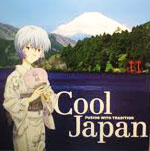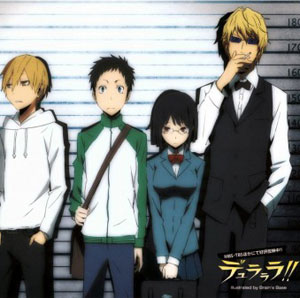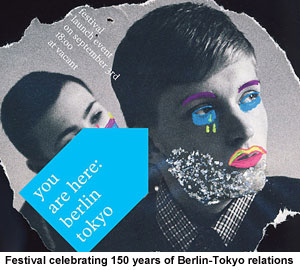
Tokyo is a key component of the country's 'Cool Japan' campaign

FRONT PAGE
About us
 

City brand Amsterdam
City brand Brasilia
City brand Bucharest
City brand Chicago
City brand Hong Kong
City brand Jakarta
City brand London
City brand Singapore
City brand Tokyo
US mayors on Twitter
Europe's top city brands
EUROCITIES branding report - a critical review
EUROCITIES on city branding
Cities into successful brand
Social media and government
Top level city domain names
Gallup's Soul of the City
Mayor of London
London City Hall

Worldwide | Elections | North America | Latin America | Europe | Asia | Africa |


























|
|
Tokyo promotes cool image
in run-up to 2020 Olympics
By Andrew Stevens*
16 January 2014: The name alone of Japan’s metropolis underlines its historic and political significance: Tokyo, or ‘eastern capital’. Having relocated the seat of government from the ‘western capital’ Kyoto to the ancient port of Edo in the 19th century at the behest of a modernized, open and newly unified nation, it was the capital’s post-war reconstruction which was to usher in the hyper-modernity which we all associate with Tokyo. Within Japan however, such modernity is often seen as a byword for inauthenticity or assimilation of the west. The Tokyo city brand is one of the world’s most embedded yet least studied.
• History
• Cool Japan
• Brand partners
• Campaigns
History
It may be that few songwriters have sought to tackle Tokyo in the way that Tin Pan Alley once did with New York, but the post-war cityscape of bustle and neon has singlehandedly scripted hundreds of films and music videos. Tokyo is certainly not short of admirers, among them style critic Tyler Brûlé who has penned numerous journalistic love-letters to the city and even acted as PR consultant for its previous 2016 Olympic bid. The novelist Paul Auster is once said to have remarked on visiting the city that it manages to combine the density of Manhattan and the sprawl of Los Angeles yet still thrive. Japanologist Donald Richie has dubbed it “the liveable megalopolis”.
Interestingly, despite its status as the world’s biggest metropolis and affluent image undiminished by two decades of national economic stand-still, Tokyo is sometimes viewed as having been eclipsed by regional rivals Hong Kong, Shanghai and Singapore, with Seoul and Kuala Lumpur fast catching up. One branding challenge currently being negotiated by city leaders is to examine whether Tokyo should remain Japan’s most global city or perhaps seek to emulate its regional rivals by reaching out to them and asserting its past pre-eminence, a wise grandfather figure among the newly-minted capitals of the Asian century. It is not surprising therefore that the Asian Network of Major Cities 21, a regular ASEAN-style summit between the capital cities, was formed on the initiative of Tokyo’s previous governor Shintaro Ishihara, in contrast to his image at home and abroad as an isolationist maverick.
Isolationism, or mono-culturalism perhaps, is often cited as a major barrier in Tokyo asserting itself not only regionally but against longstanding rivals London, Paris and New York. Indeed, urban scholars centred around the London School of Economics declined to include it in their Urban Age study in 2008 on account of its “comparative ethnic uniformity [which] has kept it from fully transforming itself into a true world city”. Further LSE-aligned studies have dismissed Tokyo’s global relevance on account of the notion that Kyoto is the “cultural heart of the country”. Regardless of the views of academics in London, the language barrier and occasional public xenophobia, not to mention the rigidly restrictive immigration system, are often cited as impediments by past and prospective visitors, but overall, so is the sentiment that Tokyo works as a city on account of its ruthlessly functional, clean, safe and efficient urban form.
Amid a political system dependent on the party machines of politicians with rural hinterlands and perennial economic hardship outside of the capital, Tokyo’s headquartered politico-media concentration and alleged ‘inauthenticity’ is viewed with either suspicion or outright hostility by political leaders outside of the capital. Several regional leaders, among them Osaka mayor Toru Hashimoto have sought to make names for themselves by calling for the relocation of capital functions to other parts of Japan. And yet economists such as Ed Glaeser have remarked that the Japanese economic miracle, while it lasted, was only possible because the key players were able to live and work in close proximity in order to make it happen.
Urban theorist Richard Florida for his part has argued that we can actually speak of one Tokyo-Osaka-Nagoya economic mega-region rather than any notion of competing political units. Some decentralisation of national bureaucracy may in fact be overdue, but as with other domestically unpopular capitals, knocking Brand Tokyo’s success will not make Japan’s other regions any better off.
Cool Japan
By default or otherwise, Tokyo finds itself as front of house for the ‘Cool Japan’ nation branding efforts undertaken by a hitherto reluctant Japanese government, which eagerly embraced the US-coined term to bracket not only its overseas marketing but also its industrial growth strategy. Such acceptance in diplomatic and bureaucratic circles, in some senses still begrudging, comes after decades of reliance on the tired ‘green tea and onsen’ image of tranquillity and harmony it wished to project as the image of Japan to underscore faltering western perceptions of growth, reliability and efficiency.
For instance, tourism chiefs may have vested all their hopes in Hollywood’s Memoirs of a Geisha as a means to get bums on ailing national airline seats, when in fact it was the quirky indie hit Lost in Translation, which gained the city overnight global impact among key audiences. While for all intents and purposes, as the name would suggest, Cool Japan can be seen as a soft power nation branding tool, the ‘Cool’ in Cool Japan is actually Tokyo as far as the concentration of design, culture, fashion and film industries are concerned, not least on account of the strong identity with global resonance of such districts as geeky Akihabara (‘electric town’), Shibuya and its iconic ‘scramble crossing, and the garish peacocking tribes of Harajuku. Even the ‘dark side’ of Japan as perhaps documented in the novels and films of Ryu Murakami has its own peculiar appeal found in the fleshpots of Roppongi and Shinbashi (a point not lost on Osaka’s mayor, who has sought to burnish his own city’s “sleazy” reputation).
As far as Tokyo is concerned however, this all points to offers within an offer as several wards (boroughs), most notably Nerima and Toshima, have also begun to smartly promote their own connections to ever popular manga and anime, with new museums and downloadable maps being announced almost monthly. Queuing visitors to the many numerous anime and manga conventions now routinely organised in the US and Europe lap up the product and don’t distinguish between the city and nation brands (although almost certainly they proclaim affinity to their own notion of ‘Japan’), which currently shows no signs of diminishing popularity. Even little Nerima, one of 23 districts of the capital, has its own global profile and European animation festival at Annecy in France, now in its 50th year.
 Brand partners and stakeholders Brand partners and stakeholders
At the metropolitan level, the stewardship of the Tokyo brand as a means of external promotion and global projection, is handled by the Tokyo Metropolitan Government, with the last Governor Naoki Inose (2012-2013) declaring it “Japan’s dynamo and heart”. The Ishihara administration (1999-2012) issued in 2006 a 10-year plan ‘Tokyo’s Big Change’ aimed at improving and enhancing the city on a number of levels by 2016, the intended year of hosting the Olympic Games according to its unsuccessful (as of 2009) bid.
Optimistically perhaps, Ishihara spoke of Tokyo as becoming “a new model city for the 21st century, leading other cities around the world” but with the goal of achieving a “beautiful and safe city” as its international profile. In particular there are strands aimed at negating some of the more malign aspects of urbanism from its post-war development through increased use of waterfront and greenery, as well as achieving a global reputation for sustainability and disaster management (both arguably largely achieved). Further strands encompass Tokyo becoming the ‘cultural hub of Asia’ (largely centred on improving its parks and museums) and ‘Attracting people from around the world’ (through a more legible public realm and highlighting uniqueness). The recent change of city leadership effectively gives the metropolis a chance to hit the reset button and reformulate its global positioning, a point not lost on Prime Minister Shinzo Abe during the elections.
Since ‘Tokyo’s Big Change’, and in response to the challenges facing the city in the light of the impact of the tsunami and earthquake, Tokyo Vision 2020 has been developed as a means of transforming the city, as part of the city’s bid for the 2020 Olympic Games. It is through achieving eight specific goals that Tokyo intends to promote its brand to the world, “presenting the world with a vision of how cities should be”: achieve a sophisticated disaster-resistant city and demonstrate Tokyo’s safety to the world; create a low-carbon society with a highly efficient, independent and distributed energy system; restore Tokyo to a beautiful city surrounded by water and greenery; connect land, air, and sea to raise Tokyo’s international competitiveness; put Tokyo on a new track to growth by raising industrial power and the allure of the city; build and show the world an urban model for a society with a low birth-rate and aging population; raise globally competent individuals by creating a society where anyone can strive for high goals; and create a society where everyone can enjoy sports and provide children with dreams.
Tourism Promotion, City Promotion and Sister Cities relations, as well as the Asian Network of Major Cities 21, are all handled by the Tokyo Metropolitan Government through relevant sections of the Headquarters. It also oversees the Tokyo International Anime Fair and Tokyo Marathon through publicly owned enterprises.
For its part, the efforts behind the Japanese Government’s ‘Cool Japan’ branding are handled by the Creative Industries Promotion Office, which was established in June 2010 within the Manufacturing Industries Bureau of the Ministry of Economy, Trade and Industry (METI) to coordinate the promotion of "cultural industries" by various arms of government such as the Agency for Cultural Affairs, METI itself, and the Ministry of Foreign Affairs. The ubiquity and state co-option of ‘Cool Japan’, not to mention aggressive challenges from the likes of South Korea, have led some commentators to question however if the Cool Japan era is drawing to the end of its natural shelf-life having peaked, with Tokyo’s street-level urban innovation platforms emerging (particularly around the creative use of green space) as having global resonance. Equally, the city’s global leadership on climate change through the C40 Group has ultimately led to more acclaim than METI’s crucially short-lived and largely domestically-geared ‘Creative Tokyo’ initiative of 2011.
Campaigns
After the Japanese authorities had embarked upon their fairly unsuccessful ‘Yokoso, Japan!’ (‘Welcome to Japan!’) slogan-centred campaign a decade ago, at least it could argue that it had a campaign to speak of. In this initial phase, Tokyo lacked any kind of strategy (since ‘My Town Tokyo’ of the early 1980s) and relied solely on the city to brand and market itself, possibly on account of the assumption it that remained ‘up there’ with the top ranked cities such as London and New York. Ostensibly where the city authorities departed from this laissez-faire mindset was with the preliminary work which went into its 2016 Olympic bid, which although submitted in 2006, had begun with the earlier (controversial) decision to change the Tokyo Marathon from an elite runner event to an open contest that now attracts considerable numbers of spectators and a city-wide ‘buzz’ (in contrast to its more elitist predecessor) annually. While Tokyo was not successful in the 2009 IOC vote to decide on the host city for 2016, a certain level of momentum was achieved by the bid which saw the city’s masterplan predicated on working towards a 2016 of a renewed city and increased global projection.
As well as events in the city such as the Marathon and International Anime Fair, the Tokyo Metropolitan Government has engaged in reciprocal tourism advertising arrangements with cities such as London, in addition to maintaining a network of overseas tourism representatives in key markets and hosting tourism and investment promotional ‘Tokyo Days’ in London and other European cities. This approach, although traditional city marketing in the conventional municipal mould, could be considered as part of a conscious effort to brand Tokyo following a significant period of stagnation. It is now on the to-do list of the new administration to refresh the offer and the strategy, having learnt the lessons of the past decade.
One of Tokyo’s major brand weaknesses is the perception of its cleanliness; the city ranks in the bottom half of all measured nations in the 2011 Anholt-GfK Roper City Brands Index (dropping from 10th city overall in 2011 to 17th in the 2013 index). There are many aspects of the cosmopolitan society in Tokyo, but the perception of closed institutions and the city’s reputation for isolationism is often cited as a key factor for it failing to compete with other cities on a regional, as well as global level. Tokyo recognizes these weaknesses and is in the process of addressing them, but whether or not they can be overcome and it can begin to compete with the likes of London and New York, as well as see off regional rivals, remains to be seen.
With thanks to Roland Kelts for comments and ideas
|
|

|



































